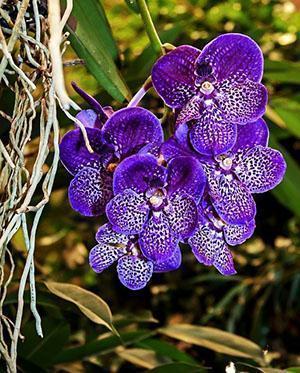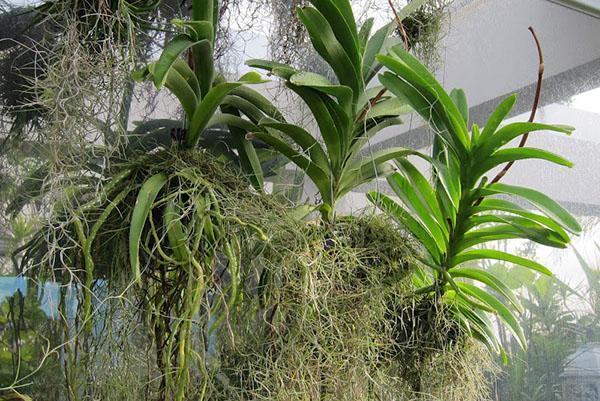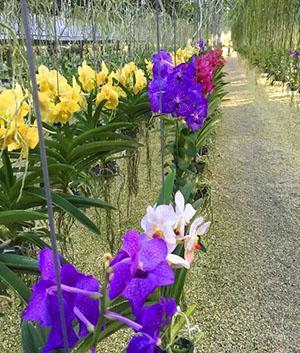The subtleties of care and reproduction of the magnificent Vanda orchid
 The genus of flowering plants from India, other regions of southern Asia and northern Australia unites more than fifty species. The Wanda orchid gained wide popularity in the century before last, when the first specimens appeared in European greenhouses.
The genus of flowering plants from India, other regions of southern Asia and northern Australia unites more than fifty species. The Wanda orchid gained wide popularity in the century before last, when the first specimens appeared in European greenhouses.
Today, orchids of this genus are one of the most popular among indoor crop lovers. The popularity of Wanda is easy to explain. Prominent, up to one meter high plants with elongated linear leaves and racemose inflorescences are quite unpretentious and can bloom several times a year. In an inflorescence that retains its decorative effect for up to 50 days, there are from 10 to 20 flowers. Orchid corollas, depending on the species and variety, can be painted in a variety of tones, but the most valuable are blue Vanda. This color, extremely rare for orchids, is also transmitted by plants when crossed, which is actively used in breeding work.

Wanda Orchid Care
Like all orchids that come from tropical regions, Wanda does not feel very comfortable indoors and requires creating conditions as close to natural as possible. Read also about the Phalaenopsis orchid!
How to grow an orchid indoors? What should be considered when leaving and maintaining a guest from the distant Indian tropics?
The best place for such a plant is a greenhouse, but not all flower growers have the opportunity to please the southern beauty this way.
 Therefore, when caring for the Wanda orchid at home, take into account that the plant:
Therefore, when caring for the Wanda orchid at home, take into account that the plant:
- does not have a long rest period;
- receives most of its food not from the soil, but from the atmosphere;
- needs to maintain the temperature in the range of 20-25 ° C with a decrease in the background at night;
- grows well and blooms at high humidity;
- does not like stagnant air, but at the same time is afraid of drafts;
- likes to be under the scattered rays of the sun for 12-14 hours a day.
If, when caring for the Wanda orchid, you do not observe the temperature regime or allow the flower to be kept in dry air, the plant inevitably weakens, the shoots become thinner, the foliage turns yellow, and flowering, if it does, does not please with splendor.
It is especially important to maintain a humidity of 60–80% and the required length of daylight hours in winter. To do this, use household humidifiers, regular irrigation of greenery and the root system, as well as artificial lighting of plants.
 Since, due to the powerful branched roots, this type of orchid is most often grown at home without a pot, but in a basket or on a block, irrigation is an important part of caring for the Wanda orchid. The temperature of the water for such spraying and watering, if the flower is placed in a glass vessel, should be several degrees warmer than the surrounding air.
Since, due to the powerful branched roots, this type of orchid is most often grown at home without a pot, but in a basket or on a block, irrigation is an important part of caring for the Wanda orchid. The temperature of the water for such spraying and watering, if the flower is placed in a glass vessel, should be several degrees warmer than the surrounding air.
Instances in transparent tall vases are watered regularly. To do this, water, purified of salts and other harmful flower compounds, is poured into a container with an orchid so as to moisten the roots. After 20 minutes, the excess water must be drained.
 This time is enough to:
This time is enough to:
- the plant has received a sufficient amount of moisture;
- locally increase air humidity;
- protect the roots from rotting during prolonged contact with water.
During the period of active growth, warm showers are included in the care of the Wanda orchid, which they spend in the morning, so that after the procedure the leaves and the surface of the roots have time to dry out.
In winter, the plant needs less moisture, and during the period of peduncle formation and bud opening, on the contrary, the need for moisture increases sharply.
Transplantation and care of the Wanda orchid
 Since this variety does not feel the need for a substrate, an orchid transplant is not needed either, but a florist cannot avoid caring for the root system.
Since this variety does not feel the need for a substrate, an orchid transplant is not needed either, but a florist cannot avoid caring for the root system.
The roots need to be regularly inspected, dried or damaged areas removed, and made sure that no foci of rot or the spread of fungal infections appear.
At home, the Wanda orchid is planted in baskets, trellised containers, or large pieces of bark and moss are used to attach a flower. To further strengthen the plant in the selected container and seal the voids, wire, steamed bark, charcoal and well-dried sphagnum are used.
 When transferring a plant from one container to another, it is important to be extremely careful with the root system. After transplanting an orchid, it is useful to include foliar feeding with a complex specialized composition in its care. Typically, such procedures for the Wanda orchid are carried out weekly using a weak solution fertilizers.
When transferring a plant from one container to another, it is important to be extremely careful with the root system. After transplanting an orchid, it is useful to include foliar feeding with a complex specialized composition in its care. Typically, such procedures for the Wanda orchid are carried out weekly using a weak solution fertilizers.
Orchid propagation and care of young plants
You can get new orchid plants by planting daughter rosettes from the parent specimen, which are formed at the base of an adult flower.
 Young plants should be separated from a large bush only when their own roots are formed. All slices during vegetative propagation of orchids and caring for them must be treated with cinnamon powder or crushed activated carbon. First, the rosettes are planted in shallow baskets with a mixture of charcoal, pieces of bark and sphagnum, and the containers are placed in a greenhouse. There young Wanda grow and actively form roots until the stem height reaches 15–18 cm. Now the plant is ready to decorate the room with lush inflorescences.
Young plants should be separated from a large bush only when their own roots are formed. All slices during vegetative propagation of orchids and caring for them must be treated with cinnamon powder or crushed activated carbon. First, the rosettes are planted in shallow baskets with a mixture of charcoal, pieces of bark and sphagnum, and the containers are placed in a greenhouse. There young Wanda grow and actively form roots until the stem height reaches 15–18 cm. Now the plant is ready to decorate the room with lush inflorescences.
Read also the article in the topic:orchid care and reproduction at home after purchase!